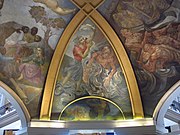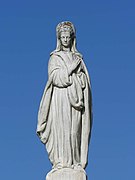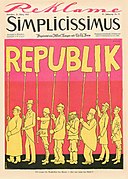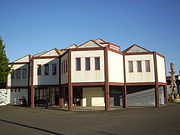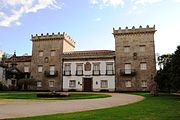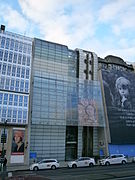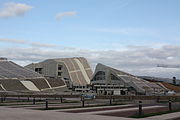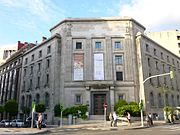Os renovadores
 Mural by Manuel Colmeiro at Galerías Pacífico in Buenos Aires | |
| Nickname | Os novos (The new ones); Os renovadores (The renewers) |
|---|---|
| Predecessor | Galician art of 19th century |
| Formation | 1920s |
| Founded at | Galicia |
| Purpose | To renew Galician plastic art |
Region | Galicia and the exile in Iberoamerica |
Os Renovadores (the Renewers)[1][2] or Os Novos (New ones)[3][4] was a group of artists who wanted to renew the visual Galician arts from the 1920s.[5]
Artists
[edit]It was a diverse movement. Maside, Souto, Colmeiro, Seoane, Eiroa, Mazas, Torres, Laxeiro and others, are considered members of the group.[5][6][7][8] José Frau is sometimes named,[9] and is also included Virxilio Blanco, who went to Cuba at a very young age.[5] For their support and influence, it is also common to include Castelao, Camilo Díaz and Asorey.[5] Some others were Urbano Lugrís, María Antonia Dans, student of Lolita Díaz (first woman member of Real Academia Galega de Belas Artes)[10] with Elena Gago; and Ángel Johán, Colombo, Cebreiro, Pesqueira, Concheiro, Bonome, etc. or the surrealists Granell and Mallo.[11] Isaac Díaz Pardo, after the murder of his father Camilo Díaz, continued the legacy of his family of artists, and renewed the forms of design and ceramics.[6][12]
The precursors
[edit]Since the Séculos Escuros (Dark Centuries), efforts to maintain the dignity of Galician culture were made in Arts (like Compostelan Baroque), Science and Education (with Martin Sarmiento and Benito J. Feijoo), and in Literature (as recent discoveries show).[13][14]
In the 19th century, some events led to a resurgence (Rexurdimento), especially in poetry.[15] In plastic arts, like in painting, there is an affinity for romantic and post-impressionist landscapes influenced by Cézanne. Among them there is a regionalist feeling for their landscapes, and some Galicians, like Valle-Inclán, accused the artistic primacy of the Madrid – Valencia axis inside Iberian Peninsule. Some of the most Galician promising artists died young and were called 'the Sick Generation'.[16]
Precursor's gallery of images
[edit]
-
O xantar, by Silvio Rodríguez, from 'landscape regionalism'.
-
Escena de romaría, de Xenaro Carrero, member of the 'Sick Generation'.
-
O gaiteiro ('The piper'), by Jaspe Moscoso. Museo de Belas Artes da Coruña.
-
Pardo de Cela by Manuel Álvarez. With the codes of the time, Álvarez reflected some of the founding myths of XIX regionalism.
-
Banho de cavalos ('Horse's bath) by Román Navarro, in Museo de Belas Artes da Corunha.
-
Estribela, by Alfredo Souto.
-
Retrato de Emilia Pardo Bazán, by Vaamonde Cornide.
-
Paisaxe de inverno by Serafín Avendaño.[a]

The vanguards
[edit]In Europe, the vanguards appeared strongly. Some Spaniard artists, specially from Catalonia, went to France (Picasso, Miró, Dalí...).[17] In the 1920s, the Xeración Nós wanted to link Galician and other European cultures, and the 'Generation of 25' emerges (the "renovators" of Galician poetry and theater).[18]
Plastic artists born in the first decade of the century don't break with older artists, such as Díaz Baliño, Castelao or Asorey, but they try to value, renew and democratize Galician tradition. Writers and plastic artists gather around El Pueblo Gallego, which begins to publish graphic and written works in Spanish and Galician.[19]
In 1921, Santiago Ramón y Cajal awarded Daniel Castelao a scholarship to learn about the avant-garde in Europe.[20] He spent almost one year traveling and he published fragments of his travel diary in the magazine Nós:
Spanish people think that to be universal (...) we who make national art (of the Galician nation) are asked to 'kill the regional spirit' and be Spanish; now I ask: if you realize that art has no borders, it means that it is cosmopolitan. Why don't you ask us to 'kill the Spanish spirit'? Well then, if Spanish art can come out of Spain, so can Galician, Basque and Catalan art.[5]
For him, art must be universal and cosmopolitan, but linked to the 'mother culture'. When he got in touch with the avant-garde art of Central Europe, he made some disqualifying comments about Picasso, who after his training in Galicia and Catalonia was developing Cubism in Paris.[21] He preferred the Russian vanguards because they were "linked to the people".[5] Later, he published an essay on Cubism, in which he became interested in its structuring of painting and reality, saying that the avant-garde could be "crazy, but not silly",[22] and corresponds with his countryman of Rianxo, the poet Manuel Antonio, searching to renew art and seeking in its roots.

Carlos Maside was one of the group who traveled the most. His work was shown in the US by the Carnegie Institute, along with M. Mallo and A. Souto. In Paris, he saw pieces of Gaugin and Van Gogh, which influenced his work beyond the Cubists, Magic realism, and Expressionism, and the writings of Bauhaus professor Kandinsky. He also made graphic works for the Statute of Autonomy campaign.[23] He helped form the Art Collection for the Seminar on Galician Studies, and suggested creating an Art Library to the City Council of Santiago. Unlike other artists who left their country, he stayed in inner exile. In Vigo, he made friends with younger artists like his nephew Xulio and Laxeiro.[24]
Manuel Colmeiro was another artist who traveled a lot, which gave him both academic and self-taught training. After the war, he went into exile in Argentina, where he created murals in Galerías Pacífico.[25] In exile, he interacted with artists like Seoane, Rafael Dieste, and Rafael Alberti.[26] He moved to Paris in 1949 and in 1989 he returned to Galicia. In the 60s, he had exhibitions in London and won several awards and recognitions in the 80s. He died in Salvaterra de Minho in 1999 at the age of 98. His daughter Elena Colmeiro was also an artist, specializing in sculpture and ceramics.[27]
Seoane talked to Freixanes about the concerns of students in Compostela during the first third of the 20th century:
The currents of "simplicismus" worried and interested a lot, within the "art nouveau". The European artistic and intellectual center began to move from Paris to Berlin both in painting and the visual arts as well as in philosophical and political thought (...) Austria was also very present, Paul Klee, Grosz... All of this, although it may seem curious, it was known in the restless Galicia of those years.[28]
-
Castelao Museum in Pontevedra
-
Mural by Seoane
Sculpture
[edit]Francisco Asorey, born in 1889 like his friend Camilo Díaz, followed figurative postulates, but with new themes and expressionist texture. Without reaching the rupturism or the iconoclasm and abstraction of the vanguards, he caused controversies, such as with a sculpture for a parish in A Estrada: the Virgin had a host on her chest and the priest didn't want it.[29] That iconography was also used by Díaz in his posters for the Statute of Autonomy of Galicia, with the coat of arms of the Kingdom of Galicia (today official of the Autonomous Community).[30]
The war took him many friends, like Díaz, but he continued in internal exile. This led to some forgetfulness later, according to his granddaughter.[31] Asorey made monuments to great figures of Galician culture, such as the Enlightenment philosopher Benito J. Feijoo, the writer Curros Enríquez or the astronomer from Lalín, Pontevedra, Ramón Mª Aller.[29] In 2019, Asorey's sculpture "A Santa" returned to Galicia for an exhibition, after 70 years in Montevideo. The sculpture, created in 1926, received criticism from notable figures such as Valle-Inclán and the Queen of Spain for breaking political correctness at the time. However, Asorey later stated in a press interview in 1956 that this was the work he was most satisfied with.[32][33]
Between tradition and renewal
[edit]
The movement in Galicia was less disruptive than other vanguards. While they valued tradition, they were very cosmopolitan, and the work of other people was fundamental to that movement, from Nós generation to scientists of the Seminary of Galician Studies, archaeologists, etc. Enrique Campo with only four years of work but very intense, practiced with new fields of drawing, archeology and scientific illustration.[34][35]
The surrealists
[edit]
Some of the Renovators were influenced by surrealism, like vivarian painter Maruxa Mallo, who had strong ties with surrealists such as Bretón, Lorca and Buñuel. She was far from his homeland, but the Galician sea was included as a theme in her work. During the fascist uprising, Mallo was in Vigo and managed to escape to Portugal. With the help of Gabriela Mistral, Chilean ambassador in Lisbon, could travel to Americas, where she was in touch with Seoane.[36] Other artists marked by the war were Francisco Miguel, killed in 1936; he worked with Siqueiros and illustrated works by Borges and Mistral. The painter Urbano Lugrís, son of Lugrís Freire, an intellectual contrary to Franco, was forced to take the side of fascism, like other artists.[37] He also worked on set designs and architecture, such as the Surrealist chapel of Magi, in Bueu.[38]


Scenography and Theater
[edit]In the 1920s, members of Irmandades were involved in theater and founded Escola Dramática Galega, with notable playwrights such as Cotarelo Valledor and Vicente Risco.[39] Noriega Varela and Cabanillas bridged the gap between 19th century and the avant-gardes.[citation needed] Cabanillas assimilates the poetry of Curros, Rosalía de Castro and Pondal, also taking modernist elements. Rafael Dieste was the most prominent author in the Generation of 25, and the scenography was diverse, with surrealist and symbolist elements.[40] Lorca founded La Barraca in the early 1930s where Lugrís and Ernesto G. da Cal participated in the scenography. Lorca wrote Six poems in Galician in 1935 as a result of his friendship with Galician artists.[41]
-
Isaac Fraga Theater in 1922. Twenty years later he built the first cinema in Galicia
-
La Barraca going to Vigo. Guerra da Cal was in the early days of the company, and acted as a 'linguistic assistant' for the Six Galician poems by Lorca.
-
Urbano Lugrís worked as a scenographer for several years with 'La Barraca'.
-
Castelao, already in exile, painting the masks for Os vellos non-deben de namorar
The graphic humor
[edit]Galician humor and satire have a long tradition, from sneering medieval poems to modern-day comics (the first Galician comic strips are published in 1888[42] and in the first decades of the 20th century drawing was analysis tool in the key of socio-political criticism or charge). Authors like Risco[43] and Otero Pedrayo, who portrayed Diego Gelmires as a comedian, used satire to comment on Galician society. Pioneers of puppetry like Barriga Verde reflected with humor the quarrels between Galicians and Portuguese, as Gabriel Feijóo had done centuries before. Artists like Maside and Díaz drew inspiration from illustrations and caricatures of Central European humor. Castelao and Luis Bagaría (although Catalan by birth, he was a close friend of a lot of Galician artists)[44][45] were two of the most influential graphic humorists in Galicia,[46][47][48] and Vázquez Díaz combined classic portraits in sculpture with satire in his penguin, closely linked to surrealism, for which he suffered censorship.[49]
-
Caricature of the Weimar Republic as a "republic without republicans". Bagaria and Castelao would receive great influence from these authors
-
Pedro Muñoz Seca
-
Antonio Vázquez Rei, by Camilo Díaz Baliño
-
Vicente Risco honored at Praça do Humor, in A Coruña
Legacy
[edit]The renewal of art influenced the next generation of Galician artists, called by some Segundos Renovadores. The exiles then participated in new forms of drawing, painting, muralism, architecture, typography or ceramics.[50] Artists such as Seoane, the Granell brothers, Maruxa Mallo and others found a great echo within the so-called "internal exile"; for example Bello Piñeiro, promoter of the Sargadelos pottery, founded upon their return to Galicia by Luis and Maruxa Seoane and Isaac Díaz Pardo among others.[51]
The typography
[edit]The renovators created new fonts and recovered traditional typography in stone, which was continued by Laboratorio de Formas. Recent creators standardized fonts based on them, such as Vila Morena by Ipanema Gráfica and Gallaecia Castelo by Carlos Núñez.[52]
Marcos Dopico and Natalia Crecente from the University of Vigo analyzed their typographic program, which combined traditional fonts from different origins with the systematization of the Bauhaus and the Ulm school,[53] and according to Díaz Pardo, the Soviet Vkhutemas.[54][55]
Graphic work was developed in a local environment, linked to areas close to the art, artisanal manufacturing, stonework or illustration (...)
The foundations set out to collect its characteristic features from history to create a system of self-expression. For this, several sources would be used; rock carving, inscriptions on church arches, petroglyphs, carving on craft tools, bread sculptures from San André de Teixido, traditional ceramics, lace from the Coast... in short, all the heritage elements of Galician culture.
The principles of modernity, with one eye on the Bauhaus and the Ulm school and the other on the uniqueness of the geographical and cultural context, avoiding any standardization, have evolved here to "enrich the world with our difference", an ideology applied to all the products they come out of the Laboratory.
-
Illustration by Luís Pintos Fonseca for Os Nenos by Xosé Filgueira Valverde
-
Two copies of the newspaper "Galicia. Diario de Vigo"
-
Head of A Nosa Terra
-
Cover of the essay 'Sempre em Galiza' (Always in Galicia) by Castelao
-
Commercial typography of Galician dairy products
-
Gothic doorway of the small cemetery of Convent of San Domingos de Bonaval in Santiago de Compostela
-
Letters in the City of Culture of Galicia in Gaiás, Santiago
On fabric research, Luís Seoane and Maria. E. Montero:[56]
In Galicia, the collaborative work between Seoane and Mª Elena Montero is paradigmatic of a way of proceeding that will be recovered in the 2nd decade of the 21st century. Seoane designed the tapestry cards in Argentina and these were made in Sada by Montero, who managed to achieve the chromatic richness of the artist's paintings. It was a feminist and pioneering collaboration in the relationship between art, design and craftsmanship, a work of respect and common creativity, as Seoane insisted that the works be signed jointly, something extraordinary for the time. In these works, the tradition of tapestry and its relationship with painting is collected, as well as the history of Galicia, its legends and battles, from the Romanesque period to the current myth of shellfish gatherers, watering cans, milkmaids, in short, women as a central figure in Galicia's memory and fortress.
Buildings in Galicia with Renovadores' work
[edit]-
Museo Galego de Arte Contemporánea Carlos Maside, in Sada
-
Pinacoteca Francisco Fernández del Riego, in Vigo
-
Pazo de Castrelos, Vigo
-
Centro Social Afundación, Vigo
-
MACUF, A Coruña
-
Museo de Belas Artes da Coruña, A Coruña
-
Afundación, A Coruña
-
CGAC, Santiago de Compostela
-
Cidade da Cultura, Santiago de Compostela
-
Casa das Artes, Fundación Laxeiro, Vigo
-
Museo Granell, in Toural Square, Santiago de Compostela
Notes
[edit]References
[edit]- ^ "Salas dos Renovadores no Museo Municipal de Vigo "Quiñones de León"".
- ^ "O Movemento Renovador da arte galega" (PDF).
- ^ "Colmeiro e Os Novos, espazos e encadramentos. MARCO de Vigo".
- ^ "LA TREMENDA HERIDA BLANCA (1950–1975)". Retrieved 2023-02-06.
- ^ a b c d e f "Os renovadores (Salas 1.5 – 1.6). Pinacoteca galega contemporánea. Museo de Vigo "Quiñones de León"". www.museodevigo.org. Retrieved 2023-02-06.
- ^ a b Rabuñal, Henrique (2021-12-27). "ISAAC DÍAZ PARDO, GALEGO BOM E GENEROSO". Henrique Rabuñal (in Galician). Retrieved 2023-02-06.
- ^ "Unha ducia de obras de Laxeiro para trazar a vida do renovador da arte galega". Praza Pública (in Galician). Retrieved 2023-02-06.
- ^ "Libro-branco-de-cinematografia-e-artes-visuais-em-Galicia" (PDF).
- ^ ARTEINFORMADO. "Seoane y el movimiento renovador, Exposición, Escultura, Pintura, mar 2018" (in Spanish). Retrieved 2023-02-06.
- ^ Coruña, Isabel Bugallal | A. (2014-01-12). "La escuela de Lolita Díaz Baliño". La Opinión de A Coruña (in Spanish). Retrieved 2023-02-06.
- ^ "Bibliografía de Pintores Gallegos, el escultor Antonio Failde Gago". www.pintoresgallegos.com. Retrieved 2023-02-06.
- ^ "Isaac Díaz Pardo, construtor de soños". YouTube (in Galician). 23 July 2013. Retrieved 2022-01-25.
- ^ "Coloquio en mil duascentas coplas galegas". consellodacultura.gal. Retrieved 2023-02-06.
- ^ "Considerações sobre o galego e o português; "Paralelo de las lenguas castellana y francesa"". www.filosofia.org; Benito Jerónimo Feijoo. Retrieved 2023-02-06.
- ^ Etnicidade e nacionalismo. GONZÁLEZ REBOREDO, Xosé
- ^ "“Xeración doente”: Ovidio Murguía, Joaquín Vaamonde, Ramón Parada Justel e Jenaro Carrero" no Museo Provincial de Pontevedra.
- ^ "A desordem e a ordem do século XX: Picasso, Gris e Miró". 1library.org. Retrieved 2023-02-06.
- ^ "Lingua Galega e Literatura. 2º Bach. Educación literaria, ABAU, tema 2. A poesía de vangarda. Características, autores e obras representativas". www.ogalego.eu. Retrieved 2023-02-06.
- ^ Turismo, Xunta de Galicia Consellería de Cultura e (2011-06-06). "Galiciana: Biblioteca Dixital de Galicia". biblioteca.galiciana.gal (in Galician). Retrieved 2023-02-06.
- ^ "Evento: Castelao en Europa. A viaxe de 1921; Cultura de Galiza". www.cultura.gal (in Galician). Retrieved 2023-02-06.
- ^ "Legado de Castelao ao "Recreo Cultural" de A Estrada" (PDF). dspace.aestrada.gal; A ESTRADA, miscelánea histórica e cultural.
- ^ López, J. (2009). "Castelao no Museo Provincial de Lugo: alma e pobo a través de tres rexistros formais". S2CID 128010244.
{{cite web}}: Missing or empty|url=(help) - ^ "Cartel de Carlos Maside". 26 August 2015.
- ^ "CARLOS MASIDE – Afundación". afundacion.org (in Galician). Retrieved 2023-02-07.
- ^ "La pareja humana / Cómo ver la obra". LA NACION; Buenos Aires (in Spanish). 2004-07-04. Retrieved 2023-02-06.
- ^ Fernández, Xosé Antón Castro; Colmeiro, Manuel (1994). Manuel Colmeiro. Editorial Galaxia. ISBN 978-84-7154-924-2.
- ^ "Colmeiro, Elena | Museo de Belas Artes da Coruña". museobelasartescoruna.xunta.gal. Retrieved 2023-02-06.
- ^ Freixanes, Víctor. Unha dúcia de galegos. p. 79.
- ^ a b "O legado de Asorey nas rúas de Galicia – Turismo de Galicia". blog.turismo.gal. Retrieved 2023-02-06.
- ^ namorarte (2015-07-14). "Os carteis do Estatuto de Autonomía de 1936". namorarte (in Galician). Retrieved 2023-02-06.
- ^ "Familia Asorey". Faro de Vigo. 2013.
- ^ "La intrahistoria de 'La Santa', la provocadora escultura, prohibida por el franquismo, vuelve a Galicia". Nova na TV "La Sexta", www.lasexta.com. (em castelhano). 5 November 2019.
- ^ "'A Santa', uma das obras mais relevantes da arte galega do s. XX". CidadedaCultura.gal.
- ^ "Enrique Campo Sobrino | Real Academia de la Historia". dbe.rah.es. Retrieved 2023-02-07.
- ^ Baixas, Mogor Rías (2015-06-04). "Mogor & Rías Baixas: Petroglifos Mogor de 1907 a 1951 – Enrique Campo Sobrino y Ramón Sobrino Lorenzo-Ruza". Mogor & Rías Baixas. Retrieved 2023-02-07.
- ^ "Maruxa Mallo; Álbum da Ciencia". www.culturagalega.org. Retrieved 2023-02-07.
- ^ anavedasideas.blogaliza.org, Wayback Machine (2014-01-04). "Urbano Lugrís" (PDF). Archived from the original (PDF) on 2014-01-04. Retrieved 2023-02-07.
- ^ "Os Reis Magos, o mar e Urbano Lugrís. Historia e arte numa capela de Bueu – Turismo de Galicia". blog.turismo.gal. Retrieved 2023-02-07.
- ^ "O Teatro Galego". centros.edu.xunta.es. Retrieved 2023-02-07.
- ^ "O teatro do primeiro terzo do XX: Irmandades, vangardas e Grupo Nós". Lengua y literatura. Xuletas. Retrieved 2023-02-07.
- ^ "Os seis poemas galegos de Lorca". AC Alexandre Bóveda (in Galician). 2018-11-07. Retrieved 2023-02-06.
- ^ "Precedentes do cómic galego". Tebeosfera.
- ^ Iglesias, Xabier (20 September 2014). "Os libros de Ánxel Casal: O BUFÓN D'EL REI". Os libros de Ánxel Casal. Retrieved 2023-02-26.
- ^ "Luis Seoane Catalogo Razonado". Retrieved 2022-01-25.
- ^ Galega, Consello da Cultura. "Luís Bagaría". Retrieved 2022-01-25.
- ^ "Bagaría". Retrieved 2022-01-25.
- ^ Lieschen. "Retrato de Luis Bagaría con Castelao ó fondo". Retrieved 2022-01-25.
- ^ LQSomos (2017-09-26). "Una conversación con el gran caricaturista gallego Castelao" (in Spanish). Retrieved 2022-01-25.
- ^ Cervantes, Biblioteca Virtual Miguel de. "Segundo libro de pingüinos : esculturas en madera de Compostela" (in Spanish). Retrieved 2022-02-21.
- ^ "EMIGRANTE DUN PAÍS SOÑADO" (PDF). consellodacultura.gal.
- ^ Bugallal, Isabel (2014-01-12). "La escuela de Lolita Díaz Baliño" (in Spanish). Retrieved 2023-02-07.
- ^ "Gallaecia Castelo – letrag". letrag.com. Retrieved 2023-02-07.
- ^ Diseño, DAG-Asociación Gallega de. "El programa tipográfico del Laboratorio de Formas de Galicia -..." dag.gal (in Spanish). Retrieved 2023-02-26.
- ^ Díaz Pardo, Isaac. "Agora intentanse facer cousas novas" (in Galician).[permanent dead link]
- ^ "Iria-Fri right Rivera Vazquez on the influence of the Wchutemás. "Díaz Baliño and Díaz Pardo, a scenography for Galicia"".
- ^ Barro López, David. A muller na historia do deseño. p. 35. ISBN 978-84-92772-74-2.
Bibliography
[edit]- Quatro renovadores da arte galega. Souto. Colmeiro. Laxeiro. Seoane (1993). Consorcio da Cidade de Santiago de Compostela. ISBN 84-88484-09-7.
External links
[edit]- https://linz.march.es/Documento.asp? Reg=r-41515 Chronicle by Freixanes on the influence of the avant-garde in Castelão and Galicia.
- A tour over 30 murals by Seoane in Buenos Aires. https://www.clarin.com/revista-enie/cartografia-oculta-luis-seoane_0_lu8nvw5Eq.html


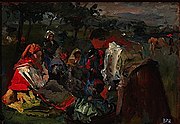





![Paisaxe de inverno by Serafín Avendaño.[a]](http://upload.wikimedia.org/wikipedia/commons/thumb/b/bb/Seraf%C3%ADn_Avenda%C3%B1o._Paisaxe_de_inverno.jpg/125px-Seraf%C3%ADn_Avenda%C3%B1o._Paisaxe_de_inverno.jpg)

